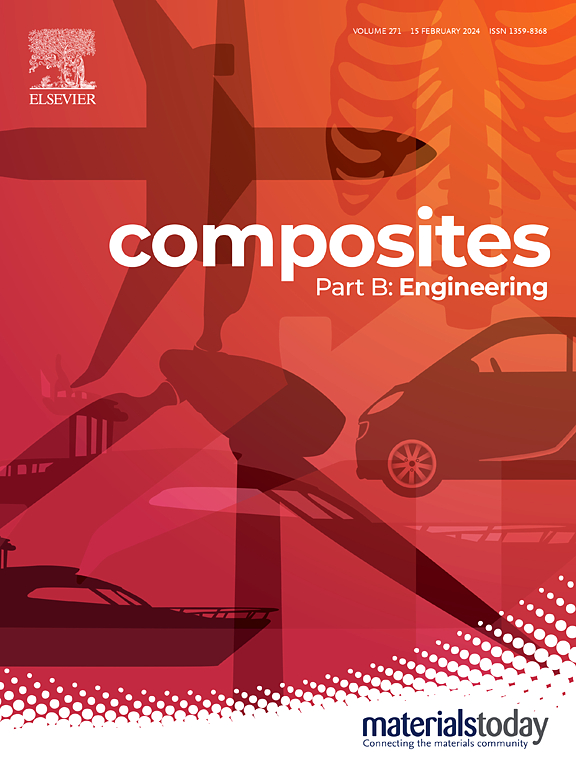Experimental and numerical study of crack propagation in an interleaved laminate reinforced by thermoplastic particles
IF 12.7
1区 材料科学
Q1 ENGINEERING, MULTIDISCIPLINARY
引用次数: 0
Abstract
The main interest of interleaved laminates is to reduce sensitivity to delamination during out-of-plane loading. Damage mechanisms such as transverse or micro-delamination cracking during in-plane loading can also be affected by the presence of an interleaf containing particles. The present paper focuses on in-plane loading. The interactions between these cracks and the particles are studied both experimentally and numerically. Tensile tests on double-edge notched specimens were carried out to identify the propagation paths of a transverse crack and a micro-delamination crack within interleaves located between 90 °/90 ° plies and 90 °/0 ° plies. The influence of interleaf particles on transverse and delamination cracking was predicted on appropriate elemental cells. The particles of the interleaf are shown to exert a local influence on the propagation of transverse or micro-delamination cracks. For a transverse crack, the interaction with the particle and the scenarios of blunting and bridging are predicted using strain energy release rate and stress intensity factors. For a micro-delamination crack, the shear modulus of the cell highly decreases with increasing crack length. Stable propagation under tensile loading but unstable propagation under in-plane shear loading is predicted.
热塑性颗粒增强交错层合板裂纹扩展的实验与数值研究
交错层压板的主要目的是降低在面外加载时对分层的敏感性。损伤机制,如横向或微分层开裂在平面内加载期间也可以由含有颗粒的交错存在的影响。本文主要研究平面内载荷。实验和数值研究了这些裂纹与颗粒之间的相互作用。对双面缺口试样进行拉伸试验,确定了90°/90°层和90°/0°层交错层内横向裂纹和微分层裂纹的扩展路径。在适当的元素细胞上预测了叶间颗粒对横向开裂和分层开裂的影响。交错层的颗粒对横向或微分层裂纹的扩展有局部影响。对于横向裂纹,利用应变能释放率和应力强度因子对裂纹与颗粒的相互作用、钝化和桥接进行了预测。对于微分层裂纹,胞体的剪切模量随裂纹长度的增加而大幅度降低。预测了在拉伸荷载作用下的稳定扩展,而在面内剪切荷载作用下的不稳定扩展。
本文章由计算机程序翻译,如有差异,请以英文原文为准。
求助全文
约1分钟内获得全文
求助全文
来源期刊

Composites Part B: Engineering
工程技术-材料科学:复合
CiteScore
24.40
自引率
11.50%
发文量
784
审稿时长
21 days
期刊介绍:
Composites Part B: Engineering is a journal that publishes impactful research of high quality on composite materials. This research is supported by fundamental mechanics and materials science and engineering approaches. The targeted research can cover a wide range of length scales, ranging from nano to micro and meso, and even to the full product and structure level. The journal specifically focuses on engineering applications that involve high performance composites. These applications can range from low volume and high cost to high volume and low cost composite development.
The main goal of the journal is to provide a platform for the prompt publication of original and high quality research. The emphasis is on design, development, modeling, validation, and manufacturing of engineering details and concepts. The journal welcomes both basic research papers and proposals for review articles. Authors are encouraged to address challenges across various application areas. These areas include, but are not limited to, aerospace, automotive, and other surface transportation. The journal also covers energy-related applications, with a focus on renewable energy. Other application areas include infrastructure, off-shore and maritime projects, health care technology, and recreational products.
 求助内容:
求助内容: 应助结果提醒方式:
应助结果提醒方式:


